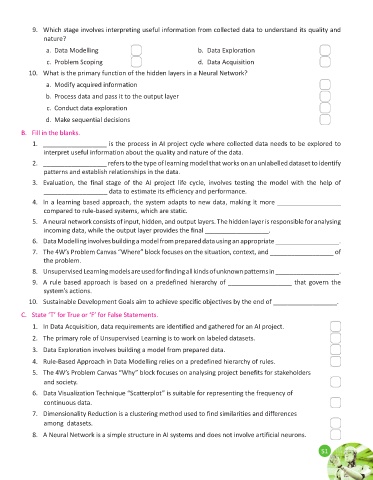Page 177 - Ai Book - 10
P. 177
9. Which stage involves interpreting useful information from collected data to understand its quality and
nature?
a. Data Modelling b. Data Exploration
c. Problem Scoping d. Data Acquisition
10. What is the primary function of the hidden layers in a Neural Network?
a. Modify acquired information
b. Process data and pass it to the output layer
c. Conduct data exploration
d. Make sequential decisions
B. Fill in the blanks.
1. __________________ is the process in AI project cycle where collected data needs to be explored to
interpret useful information about the quality and nature of the data.
2. __________________ refers to the type of learning model that works on an unlabelled dataset to identify
patterns and establish relationships in the data.
3. Evaluation, the final stage of the AI project life cycle, involves testing the model with the help of
__________________ data to estimate its efficiency and performance.
4. In a learning based approach, the system adapts to new data, making it more __________________
compared to rule-based systems, which are static.
5. A neural network consists of input, hidden, and output layers. The hidden layer is responsible for analysing
incoming data, while the output layer provides the final __________________.
6. Data Modelling involves building a model from prepared data using an appropriate __________________.
7. The 4W’s Problem Canvas “Where” block focuses on the situation, context, and __________________ of
the problem.
8. Unsupervised Learning models are used for finding all kinds of unknown patterns in __________________.
9. A rule based approach is based on a predefined hierarchy of __________________ that govern the
system’s actions.
10. Sustainable Development Goals aim to achieve specific objectives by the end of __________________.
C. State ‘T’ for True or ‘F’ for False Statements.
1. In Data Acquisition, data requirements are identified and gathered for an AI project.
2. The primary role of Unsupervised Learning is to work on labeled datasets.
3. Data Exploration involves building a model from prepared data.
4. Rule-Based Approach in Data Modelling relies on a predefined hierarchy of rules.
5. The 4W’s Problem Canvas “Why” block focuses on analysing project benefits for stakeholders
and society.
6. Data Visualization Technique “Scatterplot” is suitable for representing the frequency of
continuous data.
7. Dimensionality Reduction is a clustering method used to find similarities and differences
among datasets.
8. A Neural Network is a simple structure in AI systems and does not involve artificial neurons.
51
51

